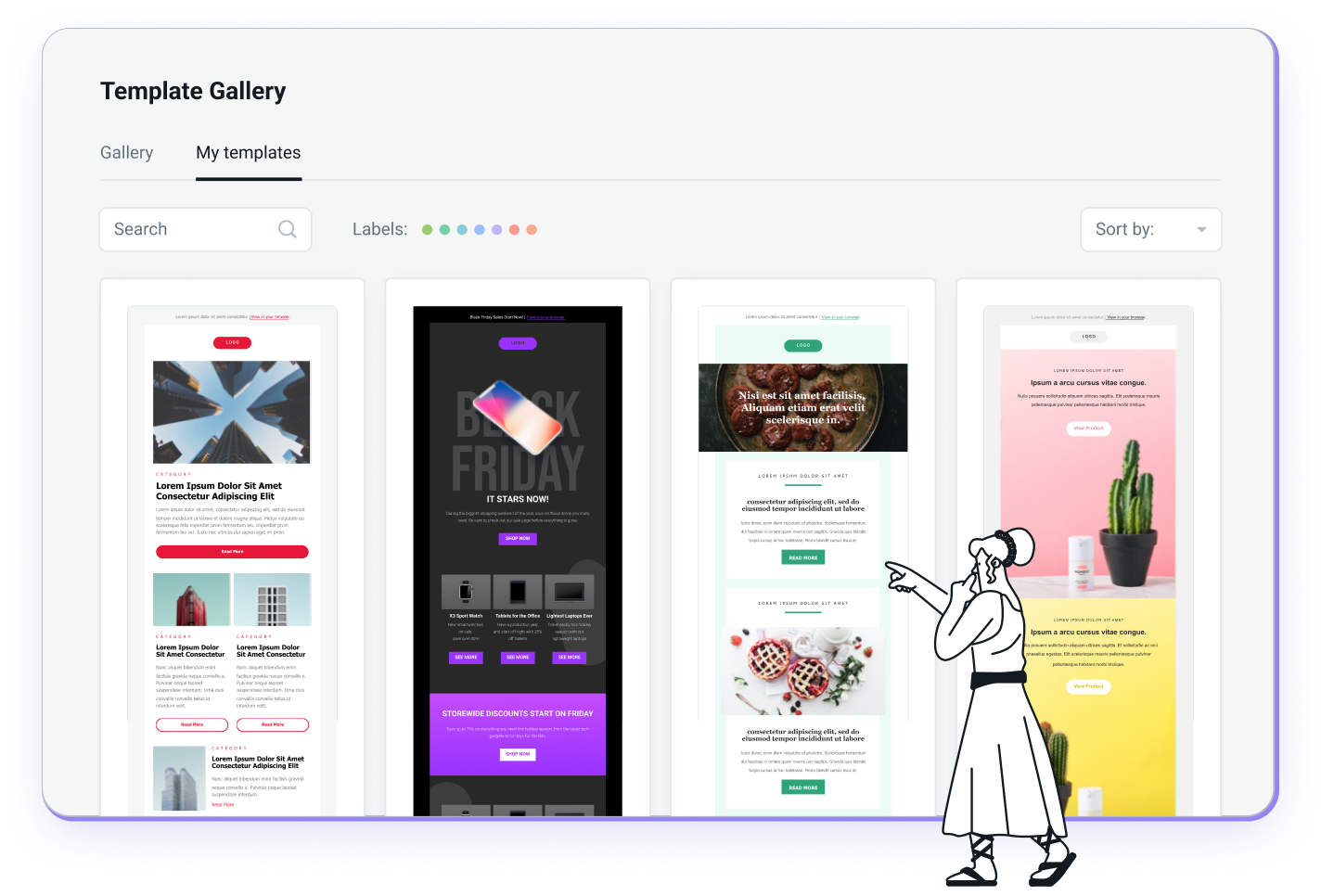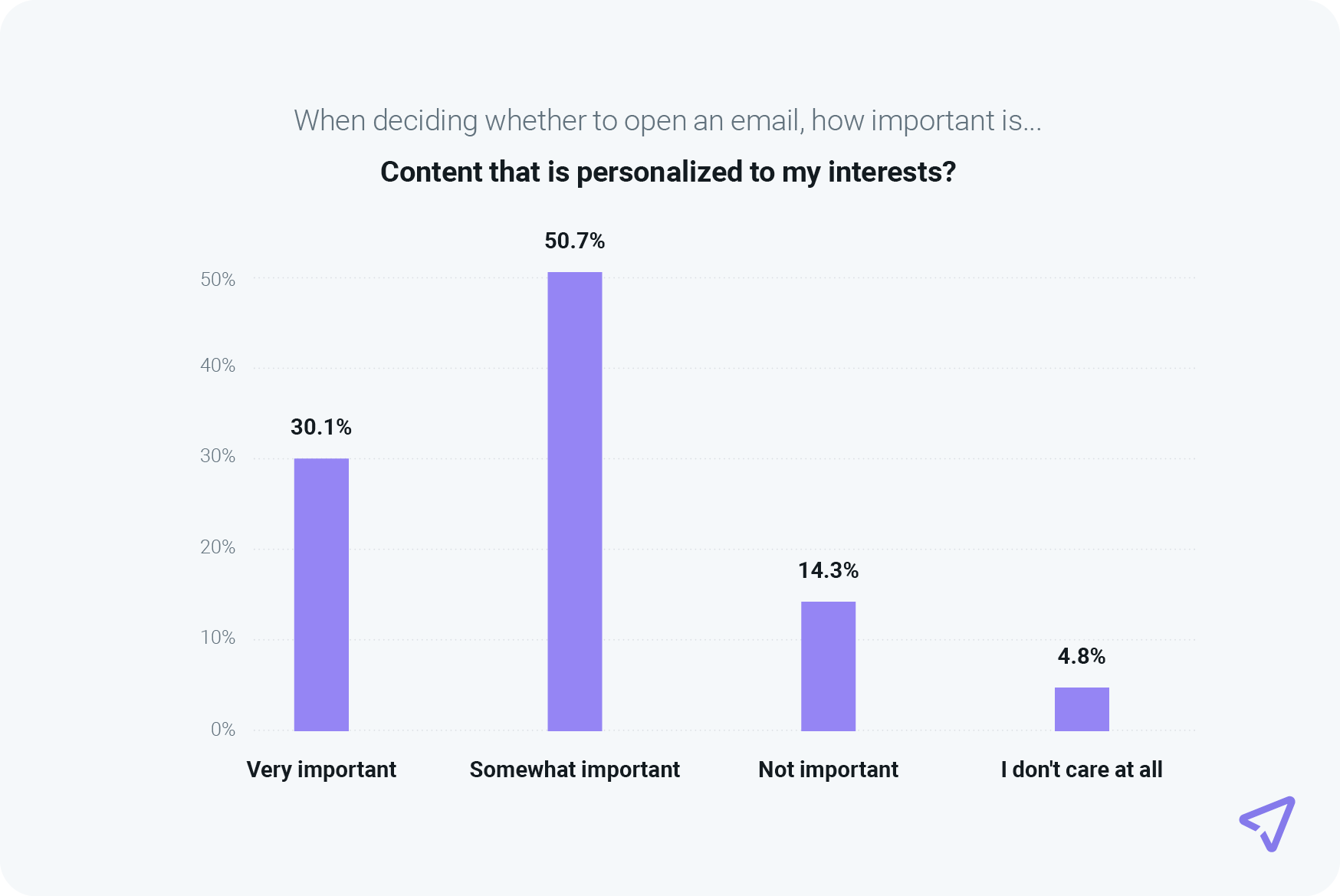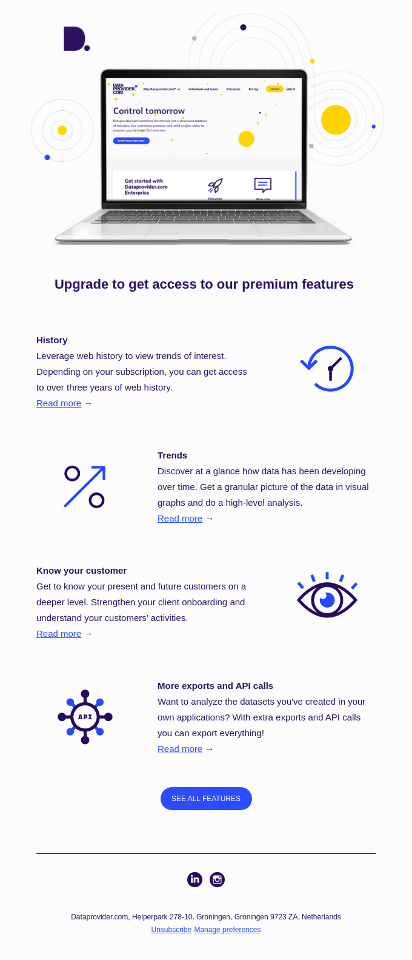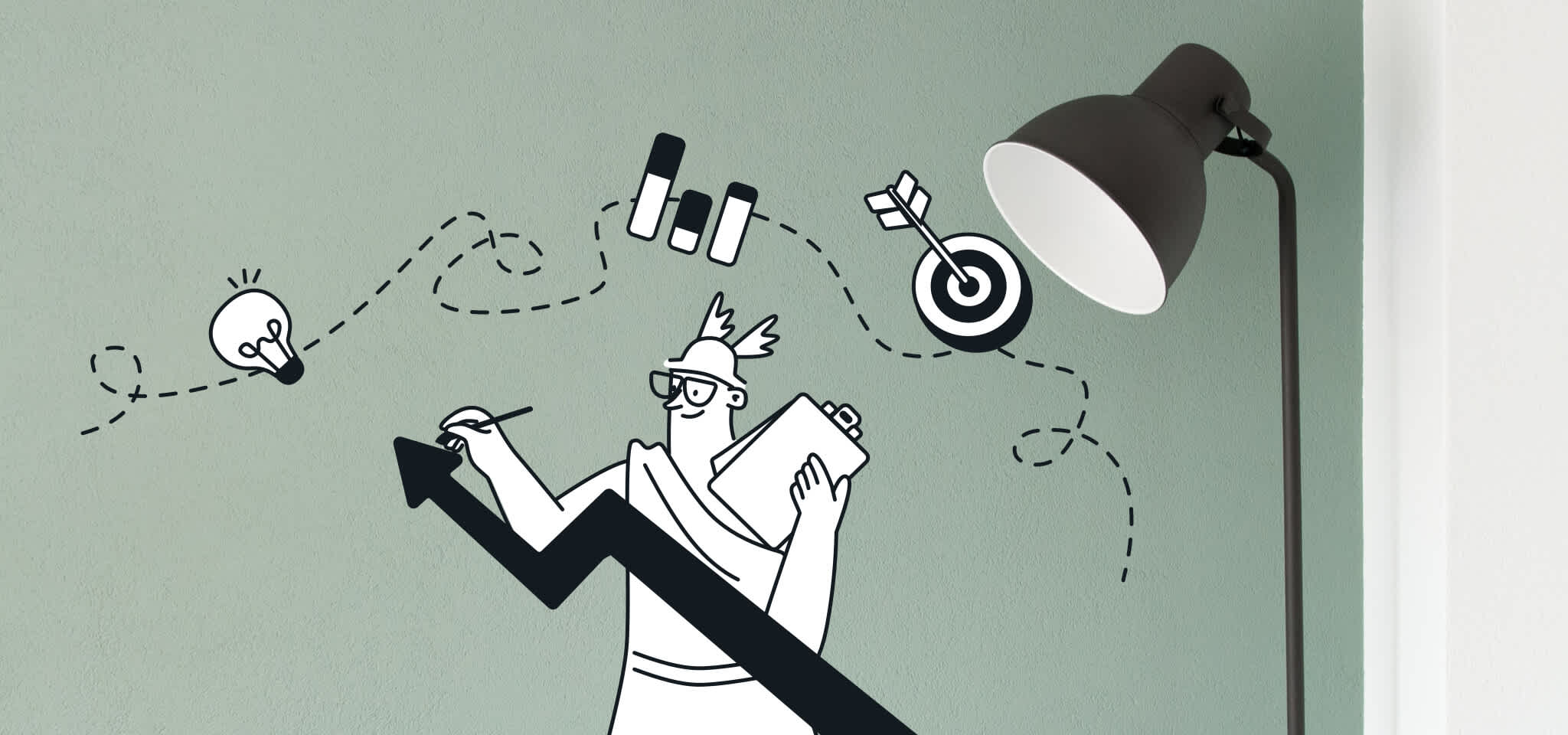Email best practices
Email marketing strategies for small businesses
Email is the best marketing channel for businesses at any stage of their growth – especially small businesses. Learn how it can help your company and the essential tips and strategies small business marketers should know.

PUBLISHED ON
There was a time when paid advertising was king for small businesses. But local TV spots, direct mail, and prominent billboards are now considered costly and difficult to track.
Now, traditional advertising has been usurped by email marketing. Its impressive return on investment (ROI) and its ability to amplify other marketing initiatives make it the best channel for businesses at any stage of their growth – including small businesses (SMBs).
Email marketing is easy to implement and deploy, even for beginners. Today, we will walk through the essential tips and strategies every small business marketer should know.
Table of content
Cost-effective marketing strategy
Build customer relationships
Customers prefer email to other channels
Build your first email list
Design email templates for your campaigns
Set your email marketing goals
Segment your email lists
Save time with email automation
Get personal
Tell the full story with your subject lines
Create a compelling call-to-action (CTA)
Perfect the landing page experience
Analyze, test, and optimize
Maintain good email list hygiene
Think mobile first
Be persistent – it pays off
The welcome email
The upsell opportunity
The sale
The newsletter
The re-engagement campaign
The anniversary email
Why email marketing is a great for small businesses
If there’s something all SMBs have in common is they don’t have money to burn. And while some marketers might argue there is no such thing as expensive or cheap marketing – only marketing that works and marketing that doesn’t –, some channels are definitely more cost-effective than others. Email marketing is undoubtedly one of those.
Most other modern marketing strategies come with pre-loaded costs and a significant element of risk. Whether you are paying for paid search ads on a major search engine, sponsored social media posts, or more traditional print media or broadcast advertising, you commit budget upfront and have no guarantee of success. What's more, the more competitive your industry, the more expensive those ads will be. This inconvenient fact is especially bad news for small companies trying to muscle their way into a market dominated by bigger players.
Email marketing is different
Email marketing is typically charged by either the number of emails a marketer sends or the size of their email lists. For small businesses just starting out, this means that costs can be incredibly low or even free. For example, a small business using Sinch Mailjet to power their email campaigns can send up to 6,000 emails to their customer base every month at zero cost. Then, as that small business grows, the next level (15,000 emails per month) starts at just $15 per month. If you think about that for a moment, that's a whole month's worth of marketing for the price of just a few clicks on a paid search campaign.
You can think of email marketing as a genuinely scalable marketing solution that grows with your business. Low costs are great, but for any marketing strategy to ever be considered useful, it needs to have real benefits for the marketer.
Thankfully, email delivers incredible benefits for marketers who follow some simple rules.
Benefits of email marketing for small businesses
Email marketing’s superpower is based on the fact that it is a nurturing and retention marketing strategy. Most other forms of marketing are acquisition strategies. As anyone who has been in business for any length of time will tell you, it is always more expensive to acquire a new customer than it is to retain an existing one.
With every great superpower comes great responsibility. The first rule of email marketing is that it should only be used to engage existing clients and subscribers who have given you permission to contact them using a signup form. Everything else is spam, and – trust us – it’s not worth it. Spam is illegal, will ruin your reputation, and never delivers on its promise.
The second rule of email marketing is that your campaigns should always be relevant, engaging, and timely. Essentially, this means sending the right message to the right person at the right time.
Get these two rules right, and email can deliver an incredible ROI for your small business. Some estimates suggest that email delivers an average ROI of $36 for every dollar spent. When you consider that average returns from paid search campaigns are estimated at just $2 for every dollar spent, you’ll begin to understand the power of email.
Cost-effective marketing strategy
Suppose you spend money on potentially expensive acquisition marketing such as paid search or sponsored social media posts. In that case, email marketing will help you deliver a greater return on that investment by helping you drive repeat purchases and building customer lifetime value (CLV).
Due to the high cost of acquisition marketing, many businesses might not generate a profit from their initial engagement. Email marketing ensures that those expensively won customers become profitable in as short a period as possible. Remember, if you are paying to acquire the same customer every time you win a sale from them, long-term profitability might not always be a given. Email marketing will help you achieve this goal.
Build customer relationships
Email marketing is a powerful strategy for small businesses because it offers a direct and personalized way to connect with customers, fostering long-term relationships. Unlike social media, where messages are often short-lived and filtered through algorithms, email allows businesses to communicate with their audience on a more personal level.
With targeted campaigns, small businesses can segment their customer base and deliver relevant, customized content, ensuring that the right messages reach the right people at the right time. This personal approach helps build trust and loyalty, which are crucial for small businesses aiming to retain customers in a competitive market.
Customers prefer email to other channels
Data from Sinch Mailjet’s 2024 report, The path to email engagement, found that 75% of consumers prefer email for both transactional and promotional messages.

Still not convinced of email marketing’s effectiveness? Sinch also asked more than 430 businesses to identify all the communication channels they use to reach customers. Results show 92% of businesses surveyed use email for customer communications, making it the top channel.

Data gathered from Sinch’s Customer connections report, The art and heart of meaningful customer connections, where hundreds of consumers and businesses were interviewed in the U.S. to help small business owners build a high-impact customer communication strategy
Still, email’s not doing it all alone. If you want to truly reach your customers on their terms, then moving towards an omnichannel channel marketing strategy should definitely be on your radar. However, you’re a small business owner with limited resources so for the moment, let’s stick with email.
Email marketing tips for small businesses
Great email starts with a solid list of subscribers. There are several methods small businesses can use to build out their lists. These include:
Following a sale.
Following a request for more information or newsletter subscription.
Following the download of an eBook, whitepaper, online catalog, video, or podcast.
Following the registration for an online event or webinar.
Important: Regardless of how you collect email addresses, you always need to ask your potential subscribers for their permission to join your lists. Your email subscribers should also be given the opportunity to leave your lists using an unsubscribe link with every subsequent send. These measures will ensure you stay compliant with global email regulations, including GDPR, CAN-SPAM, and CCPA.
Build your first email list
You’re probably wondering – when should I send my first newsletter? Is it better to send my first email to a few subscribers or should I wait until my list has grown?
The answer is quite simple: If you’re asking people to join your mailing list, make sure you’re ready to start sending emails shortly after they join. Don’t wait until your email lists have reached a significant number of subscribers before sending their first campaign. When subscribers join your list, they have expressed an immediate desire to hear from you – so don’t let them down.
It's also important to remember that email addresses may have a limited shelf life. The average age of an email address is only 16-months. People change jobs and email clients, and sadly nobody lives forever. If you wait too long before sending, your email bounce rate will be much higher than it should be.
Design email templates for your campaigns
Email marketing is mostly template-driven, which means new campaigns can be created and deployed quickly and efficiently. This will help your small business react to challenges and opportunities as and when they arise.
The ability to deploy a relevant, engaging, and timely email campaign means that if an email marketer can think of an email campaign, they can send it – quickly and efficiently.
For small business marketers, this ability to react quickly can offer a considerable advantage over larger organizations that may have to follow more bureaucratic procedures before a campaign is deployed.

Sinch Mailjet has an extensive library of pre-built templates that you can use to set up email campaigns in a matter of minutes
Set your email marketing goals
Every email you send should have an objective. Do you want to sell more, drive website visitors, or position your organization as a “thought leader” in your industry?
Understanding your goals will help you determine the nature, layout, and email content of your campaign. For example, if nurturing your subscriber list with industry insights is your primary goal, then a weekly or biweekly newsletter showcasing your latest blog content is an effective tactic. This type of newsletter will require a specific email template and layout – distinct from say transactional emails or a welcome email.
If you don’t set an objective, you’ll never know if your campaigns have been successful or not.
Segment your email lists
List segmentation is a great early strategy for ensuring you only ever send relevant emails to your target audience based on the individual requirements of their demographic. Remember, email marketing success is all about sending the right message to the right person at the right time. Failure to follow this rule will cause subscribers to disengage from your lists quickly.

With Sinch Mailjet, you can filter your contact list into segments based on subscriber data like location, age, language, and more
Save time with email automation
Email marketing automation offers significant benefits for small businesses, particularly in terms of efficiency and customer engagement. By automating routine email tasks such as welcome messages, follow-ups, and newsletters, small businesses can save time and focus on more critical aspects of their operations.
Without the budget or capacity to manually send out emails like your larger competitors, the ability to automate processes helps you level the playing field a little.
Get personal
Inboxes are as crowded as ever, with multiple businesses competing for subscribers’ attention. So, the question is, how do you get your campaign to stand out?
One of the most effective tactics small businesses can employ is personalization. Personalized emails create a more tailored experience as they address recipients by name, acknowledging past interactions, or offering content relevant to their preferences. This approach boosts engagement, with higher open and click-through rates and increased conversions. Furthermore, personalized, targeted messaging improves reduces costs by focusing on the most relevant audience and driving better ROI.
In fact, our 2024 email engagement survey found 80.8% of consumers rate content that’s personalized to their interests as very or somewhat important when deciding whether to open an email. This could be offers based on demographics, recommended products based on past e-commerce purchases, relevant articles, or even videos based on website behavior.

A great way to make your emails stand out is to include your subscriber's name in the subject line. This tactic is the first step on a wider email marketing personalization strategy that can evolve as your business grows.
Tell the full story with your subject lines
Your subject line is your first line of defense between your business and obscurity. You should write your subject lines with the same care as a newspaper editor writes their headlines – in a catchy, attention-grabbing way. A great subject line will tell the full story and let subscribers know precisely what they will get if they open the email.
Create a compelling call-to-action (CTA)
Every email needs a compelling CTA. Don't expect your subscribers to understand (or even care) what it is you want them to do after opening and reading your promotional emails. Instead, a compelling CTA should point them in the right direction by explaining exactly what will happen next on the customer journey.
Perfect the landing page experience
It doesn't matter how good your subject lines, body text, or CTAs are – if your landing page isn't optimized for conversions, any investment in email marketing or any other form of marketing will be wasted.
For example, if your email marketing goals are focused around converting subscribers to paying customers, you may decide to tempt them with a product discount campaign which directs people to a dedicated lead capture landing page. With customers now expecting a seamless, smooth, and hassle-free experience across all channels when communicating with your brand, you must ensure there’s synergy between landing page and email. Creating this aligned experience will have a positive impact on conversions.

Sinch Mailjet’s built-in landing page feature simplifies the process for email marketers wanting to create fully-aligned campaign experiences that drive product adoption, upgrades, and overall revenue.
Analyze, test, and optimize
Take the time to learn what strategies work and optimize your campaigns accordingly. A/B testing is a great way to learn how small changes to your campaigns can increase open rates, click-through rates, and conversion metrics.
If you’re unfamiliar with the concept, A/B is when you trial two separate versions of the same piece of content. This could include tweaks to the copy, subject lines, layout, sending times, etc. For example, does adding an emoji to a subject line increase opens? Does a bright red button (instead of a white button) increase clicks? Does plain text email outperform stylized graphics and fonts?
Want to know more about A/B testing? Check out Emily Benoit’s session on building a collaborative email A/B testing culture from Email Camp 2023!
Maintain good email list hygiene
While you will want to grow your list, it's important to remember that old and unresponsive email addresses will never drive any revenue. They may also damage your ability to send future campaigns, as bounced emails are often an indicator of unscrupulous email practices used by potential spammers.
That’s why list hygiene is essential. If a subscriber hasn't opened a campaign in some time, it may be worth sending a re-engagement campaign and ultimately removing any deadwood from your list.
Think mobile first
Did you know, that 71% of consumers check their emails from a mobile device, rather than their desktop? That’s just shy of ¾ of your overall audience.

To ensure your email campaign renders correctly on a mobile screen, you’ll need to ensure your email marketing software has a responsive design element. This allows emails to adapt and display correctly on screens of various sizes. For example, avoiding an image being wider than the screen or the user having to increase or reduce the size of text to be able to read it.
If you have no coding knowledge (or don’t fancy wrestling with HTML code), you use Sinch Mailjet’s Email Editor to create responsive emails which automatically adapt to any screen size.
Be persistent – it pays off
Too many marketers restrict their email campaigns to irregular newsletters, believing they might annoy their subscribers if they send too many messages. This is an unfound fear.
As long as your emails are relevant, engaging, and timely, you’ll struggle to send too many emails. Remember, your subscribers have given you permission to contact them, so don’t waste that opportunity and keep in constant contact.
6 great email marketing campaigns every SMB should incorporate
Many small business marketers will initially engage with email marketing with the idea of sending a weekly or monthly email newsletter. While regular newsletters are an important component of any email marketing strategy and are especially useful in driving traffic to other marketing channels, they are not the only campaign strategy small business marketers can deploy.
These campaigns include:
The welcome email
In many ways, the first email you send to an individual subscriber will always be the most important. The moment following a subscription via a sale or registration is when that subscriber is at their most engaged. That's why it's always a good idea to create and send every new subscriber a welcome email automatically triggered by their subscription.

Impossible welcomes its subscribers to the team with this colorful and delectable welcome email. From the top-down, they have a personalized “Welcome Smiles Davis” greeting, followed by a fun intro that incorporates their ethical mission statement. Their objective is clear: to direct their audience to the shiny yellow CTAs where they can learn more or find a store.
The upsell opportunity
When a customer makes a purchase, they share incredibly valuable information that can be used to create more targeted marketing campaigns. These campaigns will demonstrate that you are taking the time to understand your customers' needs and create the opportunity to build customer lifetime value. If an expensive acquisition marketing campaign influenced that initial purchase, that upsell marketing campaign could be your first step toward creating a profitable relationship.

Small business Dataprovider.com offers customers on free accounts the chance to upgrade to paid premium features. The email is designed to show customers the benefits of upgrading, with visual icons that lead the eye down to the CTA. Everything here moves the reader down the sales funnel to decisive action.
The sale
Approach with caution. While everyone loves a good deal, persistent discounting may reduce your ability to ever sell at full price again. So, if you are offering your loyal customers a discount, make sure you highlight these as "end-of-line" special offers or very occasional seasonal offers.

Bellroy emphasizes scarcity by putting the words “limited,” “rare,” and “last chance to buy” on the main headers. They want the reader to understand that deals like this don’t come around often. If Bellroy were to send this type of email out every month, their readers would lose trust in the brand and likely feel manipulated.
The newsletter
Nothing will drive traffic to your thought leadership content faster than an email newsletter. This is a great move for businesses hoping to position themselves as experts in their particular industry. A thought leadership campaign will take people from their inboxes to your latest blog articles, eBooks, whitepapers, webinars, podcasts, and videos.

We don’t like to toot our own horn (too much), but the Sinch Mailjet team has spent years writing email marketing thought leadership content. This means our newsletters offer valuable insights to our subscribers, positioning us as authorities amongst email service providers. Small businesses can also be authorities within their industry by hiring skilled content marketers, working with freelancers, or guest writers.
The re-engagement campaign
Not heard from a client in some time? Don’t let them become strangers. Instead, how about reeling them back into your sphere of influence with a re-engagement campaign that reminds them how they value your business? The re-engagement campaign is also a vital component of your list hygiene strategy.

Language app Duolingo understands that its users often start off motivated when learning a new language, but their enthusiasm wanes as time goes on. A little bit of encouragement from an owl will be enough for some users to “get back on track.” By not being too imposing, readers may quickly brush aside the email instead of hitting that dreaded unsubscribe button.
The anniversary email
Have you ever worked somewhere where they remember your work anniversary? It’s nice, right? Customers also appreciate this kind of gesture and anniversary emails remind them of the longevity of their relationship with you. Why not throw in a free treat, a discount, or even a poem for good measure? After all, it is their anniversary!

Grammarly uses a potent mixture of personalization, upselling, and automation to create this anniversary email. Time together is often the best metric for a relationship, and Grammarly reinforces this with a birthday cake and a big number one candle on top. Now they have your attention, a heartfelt message offers you a “special reward.” It’s a masterstroke of email design that has undoubtedly converted some free users to paying customers.
Best email marketing software for small businesses
So there you have it – our email marketing cheat sheet for small companies. As you’ve seen, many of the ideas covered here are not technical, but they do take a human-first approach. Good email marketers put subscribers' thoughts and feelings front and center, which cultivates long-term customer loyalty.
Looking for a great email provider to kickstart your email strategy? Sinch Mailjet offers small businesses a free email marketing platform, enabling you to send 6,000 emails to unlimited contacts. Create beautiful emails with our drag-and-drop Email Editor and measure success with our easy-to-understand analytical tool. As your business grows and your campaign strategies become more sophisticated, Sinch Mailjet’s scalable solution grows with your needs and requirements.








